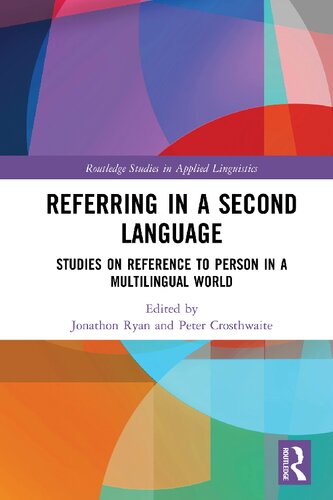

Most ebook files are in PDF format, so you can easily read them using various software such as Foxit Reader or directly on the Google Chrome browser.
Some ebook files are released by publishers in other formats such as .awz, .mobi, .epub, .fb2, etc. You may need to install specific software to read these formats on mobile/PC, such as Calibre.
Please read the tutorial at this link: https://ebookbell.com/faq
We offer FREE conversion to the popular formats you request; however, this may take some time. Therefore, right after payment, please email us, and we will try to provide the service as quickly as possible.
For some exceptional file formats or broken links (if any), please refrain from opening any disputes. Instead, email us first, and we will try to assist within a maximum of 6 hours.
EbookBell Team

4.8
64 reviews
ISBN 10: 0367208946
ISBN 13: 9780367208943
Author: Jonathon Ryan, Peter Crosthwaite
The introduction and tracking of reference to people or individuals, known as referential movement, is a central feature of coherence, and accounts for “about every third word of discourse”. Located at the intersection of pragmatics and grammar, reference is now proving a rich and enduring source of insight into second language development. The challenge for second language (L2) learners involves navigating the selection and positioning of reference in the target language, continually shifting and balancing the referential means used to maintain coherence, while remaining acutely sensitive to the discourse and social context. The present volume focuses on how L2 learners meet that challenge, bringing together both eminent and up-and-coming researchers in the field of L2 acquisition. The chapters address a range of problems in second language acquisition (SLA) (e.g., form-function mapping, first language [L1] influence, developmental trajectories), and do so in relation to various theoretical approaches to reference (e.g., Accessibility Theory, Givenness Hierarchy). The global outlook of these studies relates to the L2 acquisition of English, French, Japanese, Korean, and Spanish and covers a diverse range of situational contexts including heritage language learning, English as a medium of instruction, and the development of sociolinguistic competence.
1 Referring in a second language: Introduction to the volume
2 Referent accessibility marking and referent’s social status in Japanese as a second language
3 Use of demonstratives in oral narratives by Japanese learners of English
4 Do referential marking styles transfer to L2 story retelling?
5 Referential movement in L2 vs. Heritage Korean: A learner corpus study
6 Under-explicit and minimally explicit reference: Evidence from a longitudinal case study
7 Anaphora resolution in topic continuity: Evidence from L1 English–L2 Spanish data in the CEDEL2 corpus
8 Using the Givenness Hierarchy to examine article use in academic writing: A case study of adult Spanish-speaking learners of English
9 Referent introducing strategies in advanced L2 usage: A bi-directional study on French learners of Chinese and Chinese learners of French
10 Nominal reference in L2 French: How do adult learners manage to understand the multifunctionality of determiners and their discourse counterparts?
11 Afterword: New directions in L2 reference research
3 languages
x meaning in spanish text
how to refer to a word in a sentence
words used in second person
x meaning in between words
using x in a sentence
y in a sentence spanish
Tags: Jonathon Ryan, Peter Crosthwaite, Referring, Studies